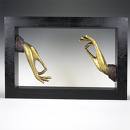I have covered various mudras prior to this post, however I wanted to cover this mudra since it the Mudra that is used most often. At the begining of a Yoga class at the end of a Yoga class. But I personally try t use it throughout the day. Most of the time when someone had made a purchase at the store, when I meet a wonderful soul or when I am in silent mediation within.
(Sanskrit) “Reverence gesture.” Also called pranamanjali. A gesture of respect and greeting, in which the two palms are held softly together and slightly cupped. Often accompanied by the verbal salutation “namaskara,” meaning “reverent salutation.” The anjali mudra has various forms, including held near the chest in greeting equals, at eye level in greeting one’s guru, and above the head in salutation to God. One form is with the open hands placed side by side, as if by a beggar to receive food, or a worshiper beseeching God’s grace in the temple.
What is a mudra? ~ (Sanskrit) “Seal.” Esoteric hand gestures which express specific energies or powers. Usually accompanied by precise visualizations, mudras are a vital element of ritual worship (puja), dance and yoga.
Among the bestknown mudras are:
1) abhaya mudra (gesture of fearlessness), in which the fingers are extended, palm facing forward;

Abhaya Mudra
2) anjali mudra (gesture of reverence); The gesture is used for both greetings and farewells, but carries a deeper significance than a simple “hello” or “goodbye”. The joining together of the palms is said to provide connection between the right and left hemispheres of the brain and represents unification or “yoking”. This yoking is symbolic of the practitioner’s connection with the divine in all things. Hence, performing anjali mudra is an honouring of both the self and the other as the gesture acknowledges the divinity of both practitioner and recipient.

Anjali Mudra
3) jnana mudra (also known as chin mudra and yoga mudra), in which the thumb and index finger touch, forming a circle, with the other fingers extended;

Jnana Mudra
4) dhyana mudra (seal of meditation), in which the two hands are open and relaxed with the palms up, resting on the folded legs, the right hand atop the left with the tips of the thumbs gently touching.

Dynana Mudra
At the end of Anjali Mudra you say eiether Namaste or Namaskara. Below is the definition of the word Namaskara.
namaskara: (Sanskrit) “Reverent salutations.” Traditional Hindu verbal greeting and mudra where the palms are joined together and held before the heart or raised to the level of the forehead. The mudra is also called anjali. It is a devotional gesture made equally before a temple Deity, holy person, friend or momentary acquaintance.
Yoga philosophy keeps me interested in my practice and keeps me wanting to learn more!! More and More and More!!!




Awesome blog!
I thought about starting my own blog too but I’m just too lazy so, I guess I‘ll just have to keep checking yours out.
LOL,
Hey, I found your blog while searching on Google. I have a blog on online stock trading, I’ll bookmark your site.